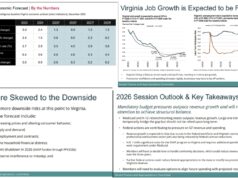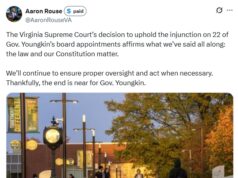From the Virginia Department of Education:
Virginia Department of Education Releases Executive Order 33 Enhanced Cell Phone-Free Education Guidance
RICHMOND – In response to Governor Glenn Youngkin’s Executive Order 33 on Cell Phone-Free Education, the Virginia Department of Education (VDOE) is releasing final Cell Phone-Free Education guidance for Virginia K-12 public schools. This guidance will ensure K-12 Virginia students have a distraction-free environment to focus on learning and reduce the alarming mental health crisis and chronic health conditions from cell phones and social media affecting Virginia students.
The Final Guidance continues to define Cell Phone-Free Education in Virginia’s public schools as “bell-to-bell”, meaning phones should be turned off and stored away from the first bell at the start of the school day to begin instructional time until the dismissal bell rings at the end of the academic school day. “Bell-to-bell” includes lunch and time in between class periods.
“We are so thankful for the collaborative input from families, educators, and students on such a critical challenge for our young people,” said Superintendent of Public Instruction Lisa Coons. “Virginians helped us shape the final guidance and our implementation supports. We look forward to continuing to work with families and educators as we help ensure that every student can have a Cell Phone-Free Education.”
The department received nearly 6,000 public comments and feedback during engagements, including 21 stakeholder convenings and public Commonwealth Conversations with over 1,160 Virginians. These comments reinforced the importance of “bell-to-bell” Cell Phone-Free Education to help teachers focus on learning and not discipline, ensure students submitted authentic work, and allow students to develop critical communication skills. Families also chimed in that they wanted their students to focus on learning and not get caught up in the drama that social media often causes during instructional hours.
Polling released by the Washington Post-Schar School of Policy and Government at George Mason University poll on Friday, September 13, show that 69% of Virginia parents of school-aged children support Cell Phone-Free Education, including during lunch and class breaks. This aligns with the overall broad, bi-partisan feedback the department received during the months of July through September.
Of the concerns raised, one common theme was around medical needs – specifically use of phone-based apps for health monitoring – and the department partnered with school nurses, pediatricians and the Virginia Department of Health to address practices for exceptions in the Guidance recognizing students with medical needs may require a medical exemption to the bell-to-bell policy included in their Individualized Education Plan, 504 plan, and/or individualized health care plans. Second, many students wrote in asking to use their phones during lunch hours. However, research shows students receive more than 200 notifications a day on their smartphones and two-thirds of U.S. students report being distracted by using digital devices. It is essential that students have the opportunity to develop face-to-face conversations and critical in-person communication skills during unstructured school hours.
Third, it became very apparent there are general gaps in parent, teacher and school communication resulting in parents feeling like they must communicate directly with their child for both emergency and non-emergency situations. Specifically, concerns focused on the ability for a parent to contact their child in a school-based emergency including during or immediately after lockdowns. The guidance has a clear section on communicating with parents during school-based and family-based emergency situations as well as non-emergency parent communications protocols. The enhanced guidance also includes a new Appendix section on School-Based Emergencies to support principals and superintendents with best practices.
In addition, Governor Youngkin has charged the Secretary of Education, the Secretary of Public Safety and Homeland Security, VDOE, and the Department of Criminal Justice Services’ Virginia Center For School and Campus Safety with supporting school divisions in the development of their required emergency response and communications plans to ensure that communications with parents during emergency situations is a top priority, consistent, and clear. A Task Force will be established to support school and division leaders with enhancing communications to and through school-based emergencies.
The Cell Phone-Free Guidance differentiates age-appropriate cell phone restrictions in Virginia’s elementary and secondary public schools.
- If a parent determines an elementary student needs to bring a cell phone or personal electronic communication device to school, it must be stored, off, and away from the student during the school day. It should not be used in the school building or on the school grounds before or after school.
- In middle school, a students should not have an easily available cell phone or personal electronic communication device during the bell-to-bell school day. School divisions should establish local policies that determine cell phone and personal electronic communication device use within the school building or on school grounds outside of bell-to-bell, including before and after school.
- In high school, students should not have an easily accessible cell phone or personal electronic communication device during the bell-to-bell school day. Outside of the bell-to-bell instructional time, cell phones and personal electronic communication devices may be used on a high school campus before or after school.
The guidance addresses students not having their cell phones “on their person” during the bell-to-bell school day, including not in their pockets. How and where cell phones will be stored during the bell-to-bell school day is a decision left to the school divisions. School divisions could choose to allow students to store their phones in their backpack, in their locker, in a locked pouch, or in a designated place in the classroom, amongst other options.
What’s Next
To continue to raise awareness about the mental health impacts of cell phones and social media cause, First Lady of Virginia Suzanne S. Youngkin and award-winning social psychologist, author of The Anxious Generation, and researcher Dr. Jonathan Haidt will be hosting a statewide conversation this Thursday, September 19 discussing the importance of Cell Phone-Free Education and strategies families can use to support our K-12 students at home. See the list of schools participating. Reach out to your school division for more information or events happening on alternate dates.
Also on Thursday, September 19, the department will release an Administrator’s Toolkit to support school leaders’ implementation of their local policies. The VDOE and the Department of Behavioral Health and Development Services (DBDHS) will announce next steps on the microgrant opportunity, with $500,000 available from existing funds to support implementation of this mental health and safety initiative and to support community conversations.
School divisions are expected to review their existing policies and, if necessary, adopt and implement age-appropriate policies and procedures aligned with the guidance on the bell-to-bell cell phone policies by January 1, 2025. School divisions may adopt policies that are more comprehensive than the guidance. The VDOE and its partner agencies expect to conduct a review process at the end of this school year to measure the guidance’s impact and consider opportunities for refinement and improvement.
Please check out VDOE’s one-stop hub for all resources, school divisions policies to date, and other useful tools on Cell Phone-Free Education.
###















